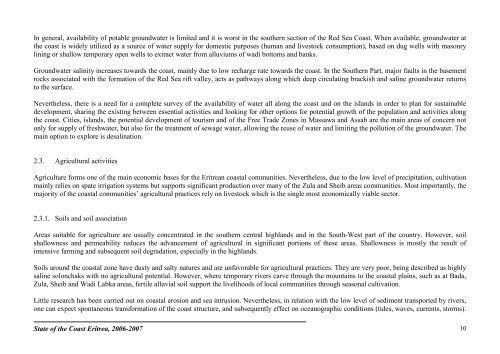Eritrea's Coastal Marine and Island Biodiversity Conservation Project
Eritrea's Coastal Marine and Island Biodiversity Conservation Project
Eritrea's Coastal Marine and Island Biodiversity Conservation Project
Create successful ePaper yourself
Turn your PDF publications into a flip-book with our unique Google optimized e-Paper software.
In general, availability of potable groundwater is limited <strong>and</strong> it is worst in the southern section of the Red Sea Coast. When available, groundwater at<br />
the coast is widely utilized as a source of water supply for domestic purposes (human <strong>and</strong> livestock consumption), based on dug wells with masonry<br />
lining or shallow temporary open wells to extract water from alluviums of wadi bottoms <strong>and</strong> banks.<br />
Groundwater salinity increases towards the coast, mainly due to low recharge rate towards the coast. In the Southern Part, major faults in the basement<br />
rocks associated with the formation of the Red Sea rift valley, acts as pathways along which deep circulating brackish <strong>and</strong> saline groundwater returns<br />
to the surface.<br />
Nevertheless, there is a need for a complete survey of the availability of water all along the coast <strong>and</strong> on the isl<strong>and</strong>s in order to plan for sustainable<br />
development, sharing the existing between essential activities <strong>and</strong> looking for other options for potential growth of the population <strong>and</strong> activities along<br />
the coast. Cities, isl<strong>and</strong>s, the potential development of tourism <strong>and</strong> of the Free Trade Zones in Massawa <strong>and</strong> Assab are the main areas of concern not<br />
only for supply of freshwater, but also for the treatment of sewage water, allowing the reuse of water <strong>and</strong> limiting the pollution of the groundwater. The<br />
main option to explore is desalination.<br />
2.3. Agricultural activities<br />
Agriculture forms one of the main economic bases for the Eritrean coastal communities. Nevertheless, due to the low level of precipitation, cultivation<br />
mainly relies on spate irrigation systems but supports significant production over many of the Zula <strong>and</strong> Sheib areas communities. Most importantly, the<br />
majority of the coastal communities’ agricultural practices rely on livestock which is the single most economically viable sector.<br />
2.3.1. Soils <strong>and</strong> soil association<br />
Areas suitable for agriculture are usually concentrated in the southern central highl<strong>and</strong>s <strong>and</strong> in the South-West part of the country. However, soil<br />
shallowness <strong>and</strong> permeability reduces the advancement of agricultural in significant portions of these areas. Shallowness is mostly the result of<br />
intensive farming <strong>and</strong> subsequent soil degradation, especially in the highl<strong>and</strong>s.<br />
Soils around the coastal zone have dusty <strong>and</strong> salty natures <strong>and</strong> are unfavorable for agricultural practices. They are very poor, being described as highly<br />
saline solonchaks with no agricultural potential. However, where temporary rivers carve through the mountains to the coastal plains, such as at Bada,<br />
Zula, Sheib <strong>and</strong> Wadi Labka areas, fertile alluvial soil support the livelihoods of local communities through seasonal cultivation.<br />
Little research has been carried out on coastal erosion <strong>and</strong> sea intrusion. Nevertheless, in relation with the low level of sediment transported by rivers,<br />
one can expect spontaneous transformation of the coast structure, <strong>and</strong> subsequently effect on oceanographic conditions (tides, waves, currents, storms).<br />
State of the Coast Eritrea, 2006-2007 10


